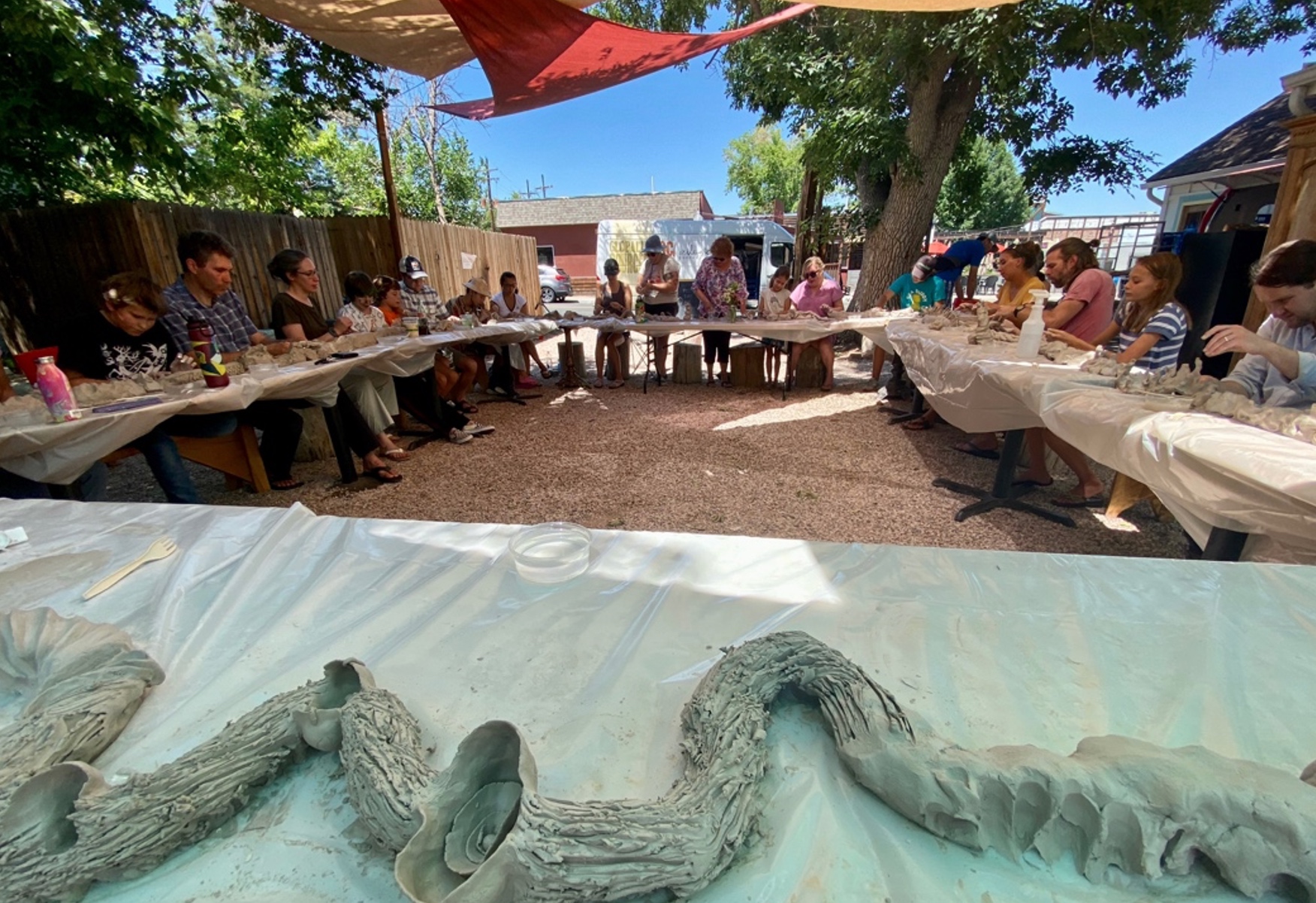By Michael Franklin, PhD, ATR-BC

Volunteers Laura Fessenden, Jordan Yates, Zoe Schlanger, Jennifer Blanchard, and Kelsey Geiger
Naropa University art therapy professor Michael Franklin, program graduates Jordan Yates and Zoe Schlanger, MA Art Therapy Candidate Kelsey Geiger, and Moxie Bread Company volunteers, together coordinated our first Open-Air Clay Art Studio (OACAS) for community members affected by the Marshal, Colorado, fire.
On December 30, 2021, at 10:30am, a small fire grew into a massive, unstoppable blaze in Marshal. Between the exceptionally dry conditions of our high desert landscape and sustained hurricane force winds up to 115 mph, the fire quickly spread to several townships destroying 1,084 structures by the end of the day. Many families lost their homes, their businesses, and entire neighborhoods. Shocked and overwhelmed, the communities of Louisville, Superior, and Broomfield, Colorado, continue to deal with the aftermath of this traumatic event.
After months of planning, on July 17, 2022, the Naropa University graduate art therapy program, in consort with its 21-year-old Naropa Community Art Studio (NCAS), partnered with Moxie Bread Company of Louisville, and Stoneleaf Pottery of Denver, to launch our first Open Air Clay Art Studio. 50 people from across the developmental spectrum, divided into two groups of 20 and 30, participated in the event. Michael Franklin offered an intervention he learned directly from poet, potter, and educator MC Richards when studying with her in 1976. Hundreds of pounds of clay were joined together symbolizing archetypal themes of connection, separateness, and the transformation of linear time-bound perception.

Open-Air Clay Art Studio for community members affected by the Marshal fire
Veering slightly from Richards’s original vision for this exercise, the goal for these groups was to first offer an opportunity to sculpt whatever emerged, and then if interested, to undo their creation and start again as a way to validate living with the trauma of impermanence related to the fires. The second intention was to explore oscillating between fragility and resiliency and to realize the innate capacity to begin again and thrive through creative transformation while living with the trauma of the fires.
Once finished sculpting the clay, everyone was invited into a witness writing practice to capture the contours and depth of their experiences. While reading aloud for all to hear, the feeling tone deepened as poetic observations about the art, the event, and the results were mutually shared. Although it was a 95-degree day, the young children who participated stayed fully engaged throughout the process. They clearly enjoyed their tactile connections with the clay while molding their ideas. Parents were able to attend to their own work without needing to excessively monitor their children. The captivating qualities of all that transpired clearly entranced everyone who participated. At the end, many people expressed their gratitude for the opportunity to join with the community in such a meaningful way.
Our Open-Air Clay Art Studio followed the guiding principles of the Naropa Community Art Studio
- To create community-focused, studio laboratories for researching the role of the socially engaged artist and art therapist. Of particular interest is the investigation of the rich territory where art is therapeutic without focusing on clinical treatment.
- To train graduate students in legitimate alternative paradigms for delivering studio-based, art therapy services to diverse communities.
- To integrate throughout our curriculum values of service as a spiritual practice by blending sitting meditation with a karma-yoga perspective of social engagement.
- To make sure that the NCAS is self-sustaining and always free for participants. Additionally, the initial goal provides community members access to thriving art studios either on the Naropa University campus or embedded directly into community spaces.
